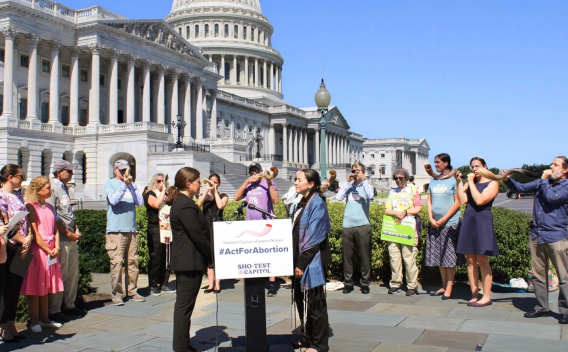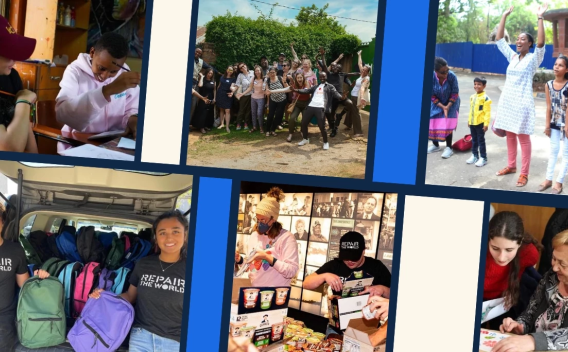By
Published
January 31, 2018
Tags
Tu B’Shvat, the birthday of trees, has long been a celebration of the natural world. Traditionally, Jews have sung, danced and planted trees in a joyous display of gratitude to the environment. That such a holiday even exists indicates how essential and central a role the earth plays in Jewish religious traditions and in our everyday lives, providing shelter, food, recreation and more.
So many young entrepreneurs are involved in sustainability initiatives that aim to protect the earth and aid humankind. Conversations with a handful of ROI Community members and REALITY alumni show how this impassioned and committed group is meeting the challenges of what Tu B’Shvat prompts us to consider: sustainability, food security, our relationship with nature and more.
“Our Mission Is to Reduce Malnutrition”
Jacob Wiesenthal, Operations Director of Semilla Nueva
What do you do?
I work for Semilla Nueva based out of Guatemala City. Our mission is to reduce malnutrition through high nutrient corn seed. Guatemala has the highest rate of malnutrition in the western hemisphere—in rural areas, it can reach up to 70 percent of children under five. That’s due in large part to the ubiquitous consumption of corn tortillas. They are a cultural staple, a dietary staple, on every table—at every meal—and they lack essential nutrients.
How did you first get interested in food insecurity?
In college, I worked with a professor who had researched Guatemala for 15 years, and I came down to Guatemala a few times with her. After I graduated, I came to work for an organization in an area that has the highest indices of poverty and chronic malnutrition. My job was to develop systems that allowed us to evaluate the impact of the organization's programs on children’s health and education. Often you’ll find this emphasis on socioeconomic inequality or violence or narco-trafficking in media coverage of Guatemala. But the factors that drive those headline items come into being early—that is, what kids are eating when they’re young.

What’s the biggest challenge you face?
We used to try and convince farmers to adopt our corn by talking about amino acids and protein and childhood development and long-term economic opportunities that come from good diets. Few farmers adopted the corn. This was early 2015. Then we did an in-depth marketing study of communities across Guatemala and found that nutrition wasn’t a motivating factor when you’re making the decision about what seed to buy. Instead, farmers cared a lot more about being good providers. So we revamped our strategy. We don’t mention nutrition at all now. We emphasize that our seed generates economic benefit and will make farmers the best possible providers for their families. Demand for our seed has since increased by ten times.
What has surprised you in your work?
How quickly it grew. In three years we’ve gone from seven to 23 employees, from reaching a few thousand people per year to reaching over 60,000 people in 2017
“Respecting the Fruit”
Aviva Paley, Director of Programs, Kitchens for Good
What is Kitchens for Good?
A social enterprise that tackles issues of food waste, hunger and poverty by rescuing produce that might otherwise go to waste and engaging students in a culinary job training program to prepare that produce into healthy meals for the hungry. Our students are primarily youth aging out of foster care and the formerly incarcerated. Everyone deserves a second chance.
In the United States, how much produce gets thrown away because it’s not pretty?
Forty percent of food produced ends up in a landfill. It’s shocking. And simultaneously, in San Diego, one in six don’t know where their next meal is coming from. Look at those opposing issues; it’s astounding. There’s a need for the redistribution of that food, but also for the processing of it. A lot of food may be bruised, maybe it looks funny, but it’s perfectly edible and delicious. That said, you don’t want to hand someone in a food line a bag of squishy tomatoes. It’s not dignified. If you hand them a beautiful tomato sauce, it’s different. That’s where we come in to process that produce.

What’s the biggest challenge you face?
Money. But also that the need out there is so much greater than our capacity. We are only able to train 100 students a year when we have about 600 applicants a year. We’re preparing around 100 thousand meals for the hungry a year when the actual meal gap in San Diego—the number of meals needed to feed everyone who’s hungry—is closer to 75 million.
What can people on the local level do to make sure everyone is fed?
I would really encourage people to invest in organizations that are lifting people out of poverty, to help get them jobs. Unless you help people get living-wage jobs, you’re not going to solve hunger.
How do you see a connection between your work and Tu B’Shvat?
So much time and energy goes into producing fruit. It’s a serious labor of love to grow a tree that takes three years to start producing fruit, so when that food goes to waste, it’s a disgrace. In my mind, that’s the tie-in—respecting the fruit.
"Sometimes it Takes a Storm"
Meg Haywood Sullivan, Photographer and Environmentalist
How do you combine photography and environmentalism?
I use my camera to tell stories about the confluence of society and our natural environments. Through my images I can peel back the layers of issues affecting us all, be it climate change or the simple change of the seasons, and moments in between. As a Protect Our Winters and Surfrider Foundation ambassador, I have a unique opportunity to leverage their voice through my craft, images, and lens through which I see the world. Aside from my creative voice, I also aim to inspire action. It’s action that produces the change we wish to see in the world. Action may take shape in the form of a beach cleanup or supporting a campaign to build climate change awareness.

What are the challenges to activating people around climate change?
Now more than ever we need to raise our voices and harness our collective reverence for the natural world. The status quo right now is beyond short-sided perpetuated by politics and business ventures that see our planet as a resource with dollar signs as opposed to something we can’t live without.
What specifically are you doing in terms of conservation?
I use my camera as a tool to inspire conservation, awareness and discussion around the threats our natural landscapes are facing now more than ever. For example, over the Fall I traveled across California and visited the National Monuments up for review by Secretary of the Interior, Ryan Zinke. My goal was to create a body of work that captured what was at stake, what we had to lose, and what was worth fighting for.
Many people feel discouraged right now—you feel hopeful?
Yes, absolutely. Being an activist in the outdoor world, I’ve seen the benefit in using platforms to speak our minds. For example, looking at what Patagonia has done, as well as other brands that I work with - taking a stand gives me hope. There’s a quote I really like that goes: “Sometimes it takes a storm to send waves your way." I think that’s applicable to our current situation.
Are there any connections between your work or worldview and Tu B’Shvat?
I respect the Jewish community. And after my REALITY trip (journey to Israel), my interest in the Jewish faith became elevated. I’m drawn to the concept of repairing the world and it’s important to implement whatever resources we have to be the best stewards of the planet. Whether it’s recycling or voting for key environmental initiatives, it’s important to vote your conscience. Let’s all do our best!
“Back to Our Agrarian Roots”
Devorah Brous, Founding Executive Director, Netiya
What do you do?
I grow food and teach communities about food sovereignty and self-reliance, and how unearthing our Jewish agrarian roots is relevant today to deepen our understandings of the seasons, and cycles of the Hebrew calendar, and our unique role as Jews in growing climate resilience. We work in Jewish, Christian and Muslim communities and bring people together to learn and share and grow, from both what’s similar in our traditions and what’s different—like around the teachings of stewardship. That is a vehicle to bridge multi-faith justice work. Ba'al Tash'chit (not wasting) is what compels me about being Jewish: we have rich and fertile teachings that come from the Torah about tithing (giving 10 percent of produce or income to charity). I’ve been trying to get congregations to put 10 percent of their unused land to food production. I’m interested in faith in action, embodying these principles in the landscape so the ideas are really tangible.

What challenges do you face?
Land is very expensive in L.A.—so we’re teaching about sustainability at 31 faith-based institutions where we've catalyzed food production but to date, don’t operate on a farm. Not all congregations see this—the landscape—as a vehicle to express their Jewishness in the world. For many, the landscape is just a landscape that requires shortsighted use of toxic chemicals and gas blowers for upkeep.
You’re based in Los Angeles. Isn’t that desert—not meant for farming?
L.A. county used to be the highest-producing county in the country. There’s full sun here. There is an issue with drought; we have to farm with a drought consciousness. Certain fruits and vegetables shouldn’t be growing here. Why not take out decorative landscapes and put in water-wise edible ones? Everywhere that Jews convene could have an element of food production to it, whether it’s a raised bed, a south-facing wall or a rooftop orchard. It’d be in keeping with the Torah. Is wasting the land and leaving it fallow in line with the Mitzvot?
How did you first get interested in issues of sustainability and food insecurity?
I grew up in a house where not wasting was one of our core values. Not everyone has food. Not wasting food, water or land, to me, is a principle that strongly guides me.
This Tu B’Shvat, take inspiration from these committed sustainability and anti-hunger advocates and think about how you can celebrate the holiday while making an impact, repairing the world and bettering your environment, wherever it is.
To learn more about Tu B’Shvat’s roots, visit MyJewishLearning.
The Charles and Lynn Schusterman Family Foundation is proud to empower emerging leaders to explore their values, identity and new ways to strengthen their communities. We believe that as we work together to repair the world, it is important to share our diverse experiences and perspectives along the way. We encourage the expression of personal thoughts and reflections here on the Schusterman blog. Each post reflects solely the opinion of its author and does not necessarily represent the views of the Foundation, its partner organizations or all program participants.




